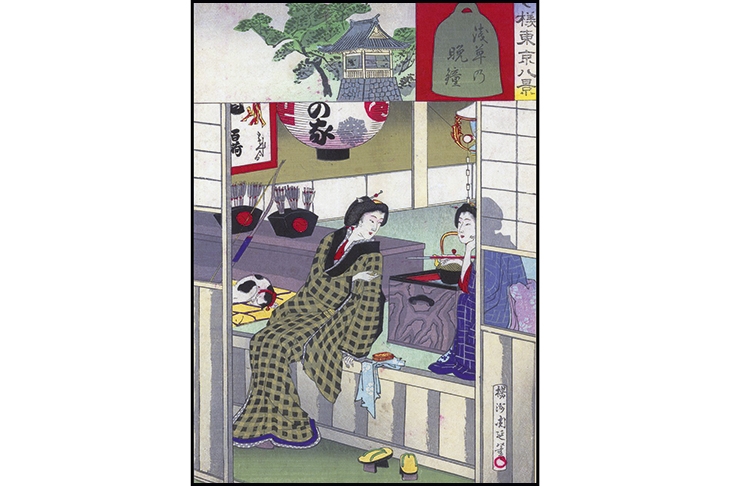In Edo (now Tokyo), before the Meiji restoration, bells marked the beginning of each hour. The hours were named after the animals of the Chinese zodiac; the cow had its own hour, as did the mouse, the chicken, the horse, etc. In winter, daytime hours were shorter than in summer, and night hours were long. The bells told people when to rise, eat and sleep. In 1872, however, Japan switched to Western time, the use of the bells was forbidden and ‘time was torn away from nature’.
Anna Sherman looks for evidence of the time bells of Edo in modern Tokyo. She describes a map that shows the sound-ranges of the bells as circles, ‘like raindrops’, that contain areas of the city and travels around and inside these circles. She visits sites where the bells once rung: a former prison and execution ground, temples and museums. In the spaces that once would have filled with their chimes, she meets and listens to people and their stories.
‘Where English has a single word for “time”, Japanese has a myriad,’ Sherman writes. Ko, from Sanskrit, describes ‘vast’ time; the setsuna, a minute measurement of time; ta-imu, taken from the English word, is ‘used for stop-watches and races’. Pico Iyer, in his book set in the months following his father-in-law’s death, talks of time in a singular sense — time that is passing. He dedicates his book to jikan, the term used most commonly in sentences containing the words ‘what is the time?’ and ‘the time has come’.
Iyer’s time is determined and inescapable, something he perhaps feels more strongly as he grows old. In The Bells of Old Tokyo, time is fluid. It is history and stories; it is the past, still present in a city that is constantly ‘destroying itself’ and rebuilding. In the face of an 80-year-old, who was eight during the fire-bombing of Tokyo, Sherman sees her daughter, ‘weaving among the ruins of a burning city; looking for me, looking for her father. Lost.’
Iyer moved to Japan 25 years ago to ‘learn how to live with less… fear of time, and to see how an old and seasoned culture makes its peace with the passing hours’. He is doomed to failure, however; he searches for an innate Japan-ness, and tries to ‘learn how to play at being Japanese’.When his stepdaughter was diagnosed with Hodgkin’s disease, she cried, then ‘picked up her culture’s sense that an argument with reality is one you’ll never win, and never cried again’. For Iyer, she is a representation of Japan, not her own person. Her actions are due to her culture, not to her strength, determination or numbness in the face of her diagnosis.
Japanese people are outsiders who cannot make themselves understood to Iyer, who himself cannot speak Japanese (through ‘laziness’, he says), and are curiosities — the men are ‘a kind of alien species impossible to get close to’. Despite the fact that he is in his wife’s country, it is his wife who comes across as foreign, her speech rendered entirely in broken English — ‘I small time,’ she begins some sentences. She is more interesting to Iyer for what she mistranslates than for what she has to say.
Listening is what Sherman is best at. Her passage around Tokyo is a form of listening, as she traces the sound-ranges of the bells. She wonders what has survived of the old soundscape of Tokyo, and of the city’s stories and histories. She speaks to monks of temples where the bells were once rung; the artist who designed a memorial for victims of the fire bombing of Tokyo that killed up to 100,000 in one night; the survivor who still regrets not saving a baby she saw crying in the ash; the artist famous for his use of LED numbers that shapeshift into other numbers, counting time or people or heartbeats; the maker of clocks that adhere to Einstein’s theory of relativity.
‘What makes you think of time?’ she asks Kobayashi, a monk. ‘Waking and sleeping. When I close my eyes, everything stops. When I open them, everything is born,’ he replies. Daibo, the owner of a coffee house, whose regulars ‘strip away armour built up over a week, or even a lifetime… Where, while waiting for their drip coffees, people… return to their true selves’, describes time: ‘If you count time in heartbeats, an elephant’s is different from a mouse’s. Each living creature has its own time.’
Iyer might regret the endorsement he gave Sherman’s book: ‘If a more soulful and original book on Japan has been published in the past few years, I haven’t seen it.’ His own book, which appeared shortly before Sherman’s, is definitely not it. In fact, if a less original book on Japan than Iyer’s has recently been published, I haven’t seen it. Sherman’s is a special book. Every sentence, every thought she has, every question she asks, every detail she notices, offers something. The Bells of Old Tokyo is a gift. Where books like Iyer’s reinforce stereotypes about Japan (he also perpetuates a harmful false narrative that American occupying soldiers after the war did not rape Japanese women), Sherman’s book does the opposite. It points us to the diversities and complexities of Tokyo, and of Japan’s histories and systems of belief. It is a masterpiece. Sherman’s Tokyo, populated by Japanese voices — authors, artists, museum stewards, people in bars, cafes,or on the street, the religious and unreligious — is mesmerising and brimming with life.






Comments